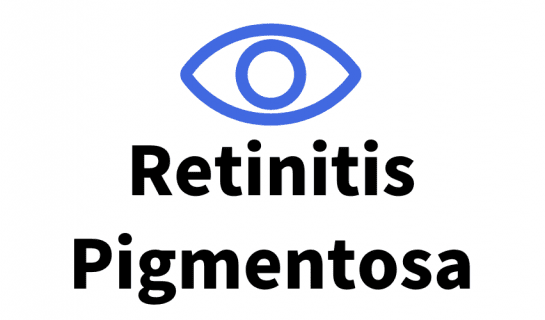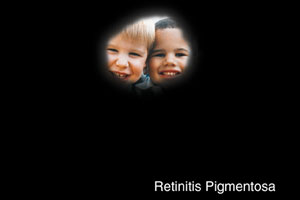Retinitis Pigmentosa

What is Retinitis Pigmentosa:
Retinitis Pigmentosa (RP) is a group of rare genetic eye diseases (also known as retinal dystrophies) that cause cells in the retina (the light sensitive layer of tissue at the back of the eye) to slowly break down over time, causing vision loss. The most common form of this condition is Cone-Rod Dystrophy.
Rods and Cones are two types of cells in the retina that gather light. The rods are situated around the outer ring of the eye and are active in dim light (affecting peripheral and night vision). Cones are the cells mostly in the centre of the retina. They help with seeing colour and detail.
Symptoms of Retinitis Pigmentosa:
Symptoms usually begin in childhood and the majority of people eventually lose most of their sight. For most versions of RP, rods are affected first. Therefore the earliest symptom is often a loss of night vision. Parents may notice their child struggle to navigate in / adjust to changes in brightness in their environment (e.g. in dimmer lighting). RP also causes peripheral vision loss (side vision) . Over time, the field of vision narrows until you only have some central vision remaining (tunnel vision). In some cases, this too will be lost. Some people with RP lose their vision faster than others and some remain stable with a moderate decline in sight. Other symptoms include; sensitivity to bright light, loss of colour vision, and struggling / not being able to make out detail.

Scene as someone fully sighted would see it.

Scene as someone with RP would see it.
How is Retinitis Pigmentosa diagnosed:
A specialist can carry out various comprehensive diluted eye examinations. These are simple painless tests where the patient receives eye drops to dilute (widen) the pupil . Thereafter retinal examinations and peripheral vision tests are undertaken. The eye is also examined for any other eye problems.
Other types of tests include:
- Electroretinography (ERG). This allows the doctor to check how well your retina reacts to light
- Optical coherence tomography (OCT) uses light waves to take a detailed picture of the retina
- Fundus Auto fluorescence (FAF). The eye doctor uses a blue light to take a picture of the retina
- Genetic testing. A doctor may recommend this to better understand what type of RP the patient has. This helps with predicting the right types / extent of symptoms, how they might develop / change, and determining the appropriate management plan to be undertaken.
Treatments for and management of Retinitis Pigmentosa:
There is no known cure for RP but the condition can be managed with vision aids and rehabilitation to help the patient make the most of their remaining vision (or lack thereof). See the ‘Further information’ section for a link to a webpage that provides more detail on managing low vision. Some useful methods for living with RP include; the use of a long cane / guide dog, always keeping your belongings in the same place, magnifying devices (physical and electronic), speech software, use of strong colour contrast in the environment, and the appropriate lighting conditions best suited to your extent of light sensitivity and night vision.
Certain vitamins and supplements may help slow down vision loss caused by the common forms of RP. However any such treatment should be discussed with and approved by a doctor to understand the risks and benefits. For example vitamin A can slow down sight loss but too much intake can cause liver problems. Other supplements also known to help include fish oil and lutein.
People with RP also tend to have other eye problems like; refractive errors, cataracts, cystoid macular edema (small pockets of fluid in the centre part of the retina). Thus, any available treatments for these conditions will assist with the management process of RP, potentially slowing down sight loss, and helping the patient make optimal use of any remaining sight.
Research into understanding and treating RP is ongoing. The National Eye Institute (NEI) are currently studying different types of gene therapy, cell therapy, and new medications as experimental treatments which may become standard in the future. Some of these experiments have resulted in improved sight in mice that had retinal degeneration and night vision in dogs. See the relevant link in the ‘Further Information’ section for more details.
Prevention / Risk factors:
RP is caused by changes in genes that control the cells in the retina. These changed genes can be inherited from parent to child. However risk levels vary because there are many types of genes that can impact retina cells so it depends on how exactly RP was inherited in your individual case. To better understand the risk of you passing down the condition, it may be useful to discuss this with a specialist ‘genetic counsellor’.
RP can also be caused by another rare genetic condition called Usher Syndrome, which affects hearing, vision, and (occasionally) balance. This condition also has no known cure but can be managed. For further information, a link to a useful webpage about Usher syndrome has been shared in the ‘Further information’ section. RP can also (more rarely) be caused by some types of medication, infections, or an eye injury.
Despite the absence of a known cure for RP, it is important to get regular eye exams to keep track of symptoms and implement appropriate treatments / training programmes to better manage the condition (see above). Regular testing would also help identify any other eye conditions which may be cured / reduced as previously mentioned.
Further information and Support:
Usher syndrome:
https://www.nei.nih.gov/learn-about-eye-health/eye-conditions-and-diseases/usher-syndrome
Living with low vision:
https://www.nei.nih.gov/learn-about-eye-health/eye-conditions-and-diseases/low-vision
NEI research news on RP:
Fight For Sight:
https://www.fightforsight.org.uk/about-the-eye/a-z-eye-conditions/retinitis-pigmentosa/
Inherited retinal dystrophies including Retinitis Pigmentosa RNIB:
https://www.rnib.org.uk/your-eyes/eye-conditions-az/retinitis-pigmentosa/
